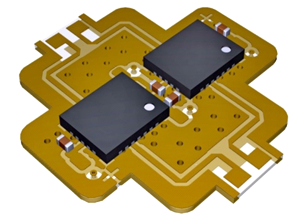High efficiency waveguide-planar amplifier with spatial power combining for frequency range 31-39 GHz
DOI:
https://doi.org/10.3103/S0735272719050017Keywords:
waveguide-planar amplifier, amplifier with spatial power combining, hybrid-integrated circuit, waveguide-planar circuit, longitudinal probe transitionAbstract
The article presents the development results of the hybrid-integrated waveguide-planar amplifier circuit for 8-mm wave range with spatial power combining. Affordable and inexpensive low-noise UMS CHA2494-QEC integrated amplifiers are used in the developed circuit. To improve the efficiency of power combining, new longitudinal probe transition designs from a rectangular waveguide to a coplanar strip line (CSL), and to a microstrip line (MSL), whose dimensions do not exceed 0.4λ0, are proposed. As a result of the amplifier electromagnetic system development, a high efficiency of power combining has been achieved up to η ≈ 85%. The paper presents the experimental results of phase-shift keyed signals transmission through the developed amplifier with a signal level that is slightly lower than the level of 1 dB gain compression. On the basis of the proposed model, the amplifier degradation was also theoretically investigated for various failure modes of one of its active elements.References
- SECHI, F.; BUJATTI, M. Solid-State Microwave High-Power Amplifiers. Artech House, 2009.
- DELISIO, M.P.; YORK, R.A. “Quasi-optical and spatial power combining,” IEEE Trans. Microwave Theory Tech., v.50, n.3, p.929, 2002. DOI: https://doi.org/10.1109/22.989975.
- JEONG, J.; KWON, Y.; LEE, S.; CHEON, C.; SOVERO, E.A. “1.6- and 3.3-W power-amplifier modules at 24 GHz using waveguide-based power-combining structures,” IEEE Trans. Microwave Theory Tech., v.48, n.12, p.2700, 2000. DOI: https://doi.org/10.1109/22.899033.
- CHOU, C.-F.; HSIAO, Y.-H.; WU, Y.-C.; LIN, Y.-H.; WU, C.-W.; WANG, H. “Design of a V-band 20-dBm wideband power amplifier using transformer-based radial power combining in 90-nm CMOS,” IEEE Trans. Microwave Theory Tech., v.64, n.12, p.4545, 2016. DOI: https://doi.org/10.1109/tmtt.2016.2623781.
- MEIER, P.J. “Printed-circuit balanced mixer for the 4- and 5-mm bands,” IEEE MTT-S Int. Microwave Symp. Dig., 30 Apr.-2 May 1979, Orlando, USA. IEEE, 1979, p.84-86. DOI: https://doi.org/10.1109/mwsym.1979.1123979.
- KANEDA, N.; QIAN, Y.; ITOH, T. “A broad-band microstrip-to-waveguide transition using quasi-Yagi antenna,” IEEE Trans. Microwave Theory Tech., v.47, n.12, p.2562, 1999. DOI: https://doi.org/10.1109/22.809007.
- RELJIĆ, Boro M. “Novel MIC/MMIC compatible microstrip to waveguide transition for X band without a balun,” Mikrotalasna Revija, June, p.16, 2007.
- CHUANG, J.-K.; FANG, R.-Y.; WANG, C.-L. “Compact and broadband microstrip-to-waveguide transition using antisymmetric tapered probes,” Electron. Lett., v.48, n.6, p.332, 2012. DOI: https://doi.org/10.1049/el.2011.3673.

Downloads
Published
2019-05-27
Issue
Section
Research Articles

